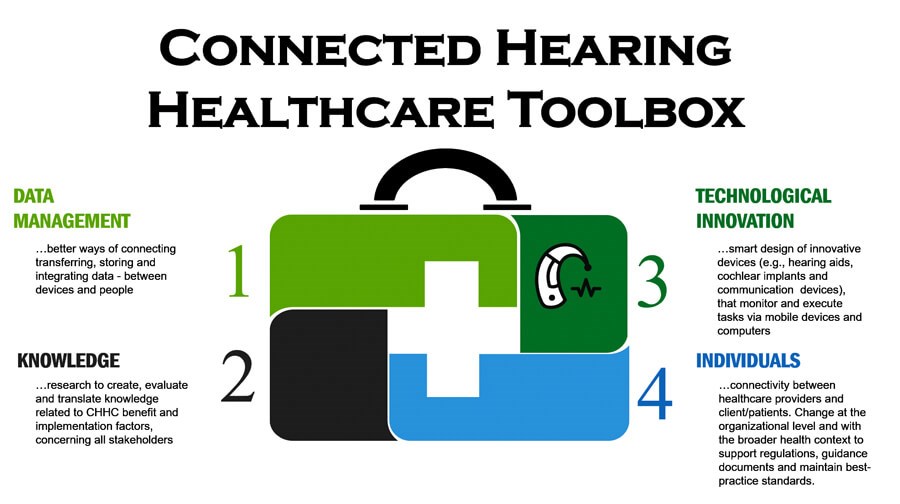Connected hearing healthcare is the one of best tools for improving access to, as well as the overall quality, of hearing healthcare. Evelyn Davies-Venn and Danielle Glista discuss the benefits and important factors that contribute to successful implementation of this innovative form of hearing service delivery
The global prevalence of hearing loss (HL) is expected to increase to an estimated 900 million individuals by 2050 [1]. This projected growth will put enormous pressure on a system of hearing service delivery that is already strained. The need to improve access to hearing healthcare services in low and middle-income countries where services are limited is generally well-understood. This need, however, also exists in developed North American regions such as the USA and Canada where the patient-provider ratio is estimated at 4:100,000 [2] and 6:100,000, respectively [3]. The World Health Organization (WHO) reports that 90% of individuals with hearing loss in low-to-middle income countries lack access to hearing healthcare services. Individuals in some rural communities in North America face similar access limitations [4].

Figure 1. Illustration of four main components that contribute to connected hearing healthcare. Successful realisation of this model of hearing service delivery depends on data management, knowledge acquisition and transfer to all stakeholders (i.e. patients, practitioners, and policy makers), smart user-design of innovative hearing instruments and connectivity across healthcare providers within the broader health context of a shared-economy medical model.
For the afflicted individual, untreated HL is associated with a myriad of negative consequences, including reduced rates of academic achievement and poorer vocational outcomes [5]. These projections indicate an impending epidemic that necessitates the development of innovative service delivery methods for addressing the need for quality hearing healthcare services [4,5]. Connected hearing healthcare (CHHC) has the potential to address these universal challenges in modern healthcare using innovative service delivery models, which extend beyond traditional face-to-face service delivery to provide services at a distance. Although there is widespread agreement around the importance and potential benefit of CHHC, the realisation of these benefits relies on successful implementation. This article will discuss implementation factors important to the successful uptake of CHHC in the field of audiology, and the idea that implementation is a dynamic process that is influenced by the support of stakeholders at many levels.
What do we mean by connected hearing healthcare?
CHHC could be defined as an omnipresent access to healthcare that integrates big data, technology and machine learning to individualise healthcare services for everyone. It has been defined as a conceptual model for health management where devices, services or interventions are designed around the patient’s needs, and health-related data is shared, in such a way that the patient can receive care in the most proactive and efficient manner possible. All stakeholders in the process are ‘connected’ by means of timely sharing and presentation of accurate and pertinent information regarding patient status through smarter use of data, devices, communication platforms, and people [6].
Instead of just using a single medical device to treat an isolated condition, the ideal form of this service delivery model could function using a shared-medical economy model that provides services on an as-needed basis while also accruing information that helps enhance treatment for chronic conditions such as hearing loss. CHHC will require the healthcare provider (HCP) to interface with cutting edge technology to not only enhance the quality of their services to their clients/patients, but also to improve the treatment experience/outcome, using a person-centred service delivery approach. Figure 1 illustrates a toolbox of essentials in the CHHC model.
Successful implementation will therefore depend on our profession’s state of ‘readiness’ to translate this potential and the growing body of CHHC knowledge into practice. In eHealth, implementation involves a plethora of factors such as technology, organisational structures, change management, economic feasibility, societal impacts, perceptions, user-friendliness, evaluation and evidence, legislation, policy and governance [7]. Within audiology, early literature has suggested generally positive attitudes and willingness on the part of the HCP to integrate CHHC services into practice [8,9]. However, there is a need to supplement these positive findings with a more holistic understanding of the factors that will influence adoption of CHHC considering all influential domains and stakeholders: clients/patients, hearing health service providers and their support staff, policy makers and significant others. As discussed by Moodie and colleagues, a collaborative, dynamic and iterative approach in translating knowledge to clinical practice has been useful in audiology and in the broader healthcare context [10].
Factors as perceived by North American healthcare practitioners
Current research efforts in North America have highlighted the continued willingness of the hearing healthcare provider to engage in CHHC service delivery to improve outcomes for their clients/patients and the need for better guidance on the part of researchers and the broader health context to influence clinical implementation. An online questionnaire was administered to audiology practitioners across the United States to survey a broad range of categories that entailed their willingness to adopt eHealth models for various audiological services. Results from this survey revealed that most professionals were also willing to adopt CHHC models for most services, except hearing aid programming and diagnostics. The factors that had the greatest influence on HCPs’ unwillingness to adopt eHealth models for hearing assessment and hearing-aid service delivery were related to reimbursement, licensing and safety [11].
Considering the perceptions of Canadian audiologists, recent work using Concept Mapping has identified key concepts related to the clinical implementation of CHHC specific to the provision of follow-up, remote hearing aid fitting services. At the top of the list are the following concepts: 1) technological infrastructure (in the practice context); 2) perceived benefit to the client/patient; and 3) client/patient access to/capability with technology. Many of the factors discussed by the 42 clinicians in this study related to the need for knowledge/training around how to best manage clinic workflow in the context of CHHC service delivery (e.g. appointment scheduling, billing, best-practice standards), while providing patient/family-centred care [12].
The clear message from the collection of emerging studies: as a profession, we have some work to do to support and enable our HCPs in the uptake of CHHC. There is need for planning and development efforts within the field of audiology, including structured training efforts, the creation and dissemination of protocol/guidance documents, greater dissemination of CHHC research, and regulatory revisions, to support effective clinical implementation of CHHC initiatives. It is also clear that the attitudes of HCPs remain positive when it comes to the possibilities of CHHC in providing high-quality care and improving access to services.
Summary and looking into the future
CHCC offers the potential to improve access to hearing healthcare for individuals with hearing loss. Future research efforts should include various stakeholders to incorporate a broad range of perspectives including those at the level of client/patient, the organisation and the broader health context. For the client/patient, the benefits of CHHC may relate to better access to quality hearing healthcare, better speech understanding in noise and empowerment over their hearing healthcare decisions. The following 3 steps should be considered as we strive to improve uptake of CHHC within the field of audiology:
- The provision of knowledge and training around hearing technological innovations.
- A better understanding of the attitudes and aptitudes of both the HCP and the individual with hearing loss.
- Change and support at the level of the organisation and the broader health context – relating to improved practice context, regulations and guidance documents, to name a few examples.
References
1. World Health Organisation (WHO). Deafness and Hearing Loss Factsheet. Geneva: Switzerland.
www.who.int/news-room/
fact-sheets/detail/
deafness-and-hearing-loss
Last accessed September 2019.
2. American Speech-Language-Hearing Association (ASHA). At a Glance: How Does Your State Measure Up—in Audiologists?
https://leader.pubs.asha.org/
doi/10.1044/leader.AAG.19032014.28
Last accessed September 2019.
3. Speech-Language & Audiology Canada (SAC). Statistics Map Canada.
www.sac-oac.ca/sites/
default/files/resources/SAC-OAC_Stats
_Map_Canada_EN.pdf
Last accessed September 2019.
4. World Health Organisation (WHO). Multi-country Assessment of National Capacity to Provide Hearing Care. Geneva: Switzerland.
www.who.int/pbd/publications/
WHOReportHearingCare_Englishweb.pdf?ua=1
Last accessed September 2019
5. Wilson BS, Tucci DL, Merson MH, O’Donoghue GM. Global hearing healthcare: new findings and perspectives. The Lancet 2017;390(10111):2503-15.
6. Caulfield BM, Donnelly SC. What is connected health and why will it change your practice? QJM: An International Journal of Medicine 2013;106(8):703-7.
7. van Dyk L. A review of telehealth service implementation frameworks. International journal of environmental research and public health 2014;11(2):1279-98.
8. Swanepoel DW, Hall III JW. A systematic review of telehealth applications in audiology. Telemedicine and e-Health 2010;16(2):181-200.
9. Singh G, Pichora-Fuller MK, Malkowski M, et al. A survey of the attitudes of practitioners toward teleaudiology. International Journal of Audiology 2014;53(12):850-60.
10. Moodie ST, Kothari A, Bagatto MP, et al. Knowledge Translation in Audiology: Promoting the Clinical Application of Best Evidence. Trends in Amplification 2011;15(1):5-22.
11. Davies-Venn, Witherell and Caroll (2016). eHealth and hearing service delivery: Can audiologists deliver what patients want? Research presentation at the American Academy of Audiology Conference, Phoenix, Arizona; 2016.
12. Glista D, Moodie S, Scollie S. Factors that influence clinician adoption of remote hearing aid fitting support. Conference presentation. Hearing Across the Lifespan. Cernobbio, Lake Como, Italy; 2018.
Declaration of Competing Interests: Evelyn Davies-Venn and Danielle Glista serve on the expert advisory panel of the Sonova AG eSolutions initiative. Danielle Glista holds a Research Grant awarded by Sonova to conduct independent research.







